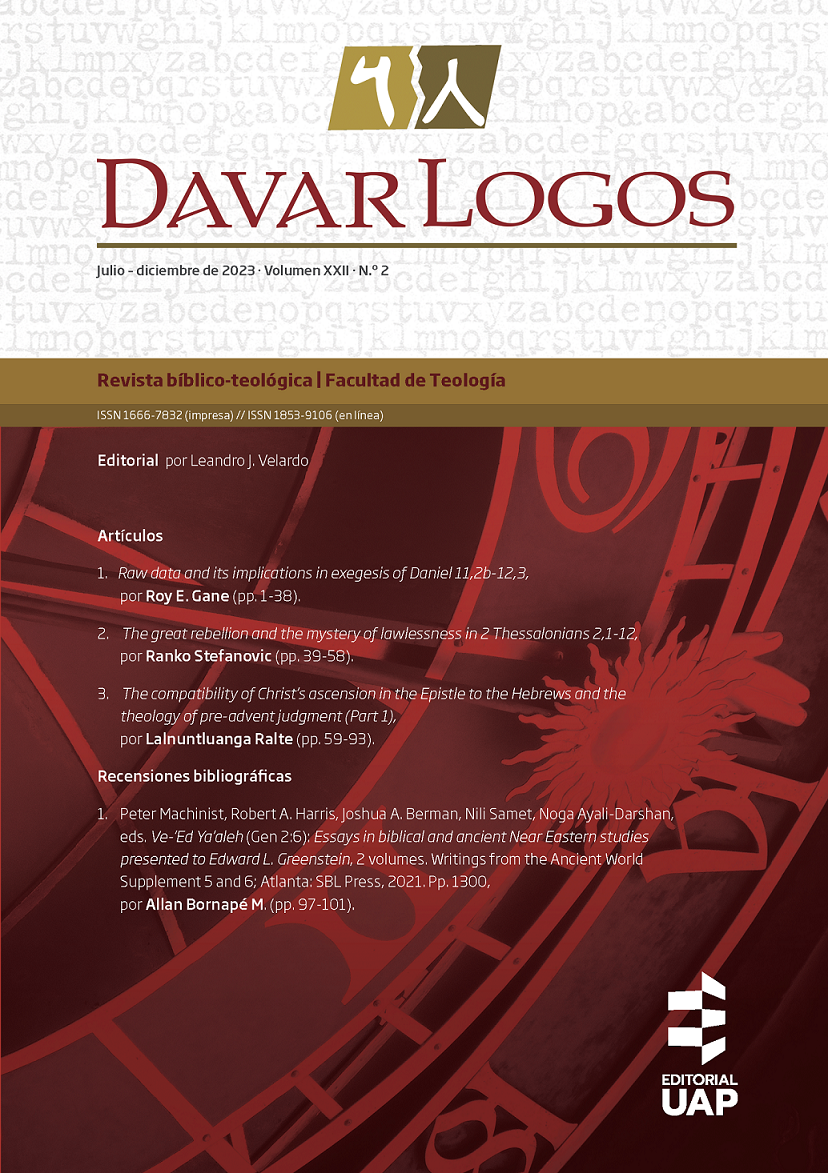Los datos sin procesar y sus implicaciones en la exégesis de Daniel 11,2b a 12,3
DOI:
https://doi.org/10.56487/dl.v22i2.1102Palabras clave:
Datos sin procesar − Discurso − Literalidad − Intratextualidad − Acontecimientos históricosResumen
Hay tres tipos de datos sin procesar en Daniel 11,2b a 12,3, que tienen implicaciones cruciales para la interpretación. En primer lugar, estos versículos conforman una unidad de discurso que comienza con lenguaje literal. Por lo tanto, toda la unidad es básicamente literal. En consecuencia, los versículos 11,2b-12,3 son la tercera explicación angélica (con elaboración) de la visión simbólica de 8,3-14, tras las explicaciones de 8,17; 19-26 y 9,24-27. En segundo lugar, estas tres explicaciones paralelas comparten puntos de contacto terminológico intratextuales. Así, los contextos de palabras en los capítulos 8 y 9 que reaparecen en el capítulo 11 iluminan contextos similares en el capítulo 11.
En tercer lugar, la correspondencia entre el lenguaje de los perfiles literarios de Daniel 11 y los acontecimientos históricos requiere una identificación precisa de los datos históricos sin procesar. Así, el versículo 40 no predice la “herida mortal” de la iglesia de Roma infligida por la Francia atea en 1798 d. C. En los versículos 40-43, la iglesia religiosa-política, el “rey del norte”, derrota al “rey del sur” religioso-político: el poder islámico.
Descargas
Referencias
Roy E. Gane, “The un-manifestation of Antiochus IV Epiphanes in Daniel 11:1-22” (paper
presented at Current Issues in Eschatology Symposium, Berrien Springs, MI, 2007); Gane,
“Methodology for interpretation of Daniel 11:2-12:3”, Journal of the Adventist Theological
Society 27, nos 1-2 (2016): 294-343; Gane, “Religious-political Papacy and Islamic power
in Daniel 11” (paper presented with PowerPoint at Daniel 11 Conference, Berrien Springs,
MI, October 20, 2018); Gane, Understanding Daniel 11:2-12:3 in seven steps (Doral, FL:
Inter-American Division Publishing Association, 2018), also translated into Spanish as Cómo
entender Daniel 11:2-12:3 en siete pasos; Gane, “Religious-political Papacy and Islamic power in
Daniel 11”, DavarLogos 19, no 2 (2020): 37-70; Gane, “Review of: Jacques B. Doukhan, Daniel
decoded: An exegetical, historical, and theological study” (Berrien Springs, MI: Andrews
University Press, 2019)”, Andrews University Seminary Studies 58 (2020): 152-55. For these
resources, except for the book Understanding Daniel 11:2-12:3 in seven steps, see http://www.
daniel11prophecy.com
ESV here and in subsequent biblical quotations in English translation, unless otherwise
indicated, with words in brackets supplied.
Cf. this Hiphil verb in 10,11-12.
See the term וןֹז ָח in 8,1-2.13.15.17.26, with the same vision referred to in 9,21
See, e.g., Amélie Kuhrt, The Ancient Near East c. 3000–330 BC, 2 vols. (London, GB: Routledge,
, 2:670-71; J. Paul Tanner, Daniel, evangelical exegetical commentary (Bellingham, WA:
Lexham, 2020), 648.
See, e.g., Tanner, Daniel, 648-49. For detailed history of the period between the death of
Alexander and the triumph of Rome over the Greek kingdoms, see Peter Green, Alexander to
Actium: The historical evolution of the Hellenistic Age (Berkeley, CA: University of California
Press, 1990).
E.g., John J. Collins, Daniel: A commentary on the Book of Daniel, Hermeneia (Minneapolis,
MN: Fortress, 1993, 25-26; Carol A. Newsom with Brennan W. Breed, Daniel: A commentary,
Old Testament Library (Louisville, KY: Westminster John Knox, 2014), 6-7.
For identification of such anaphoric references in Daniel 11, see Tarsee Li, “A color-coded translation of Daniel 11:2b–12:3” (paper presented at the Daniel 11 Conference, Berrien Springs,
MI, March 9, 2023), http://www.daniel11prophecy.com/uploads/1/1/3/7/113721993/a_
color-coded_translation_of_daniel_11_tarsee_li[2].pdf; Tarsee Li, “A few observations on
the text of Daniel 11 and current Adventist interpretations” (paper presented at the Daniel 11
Conference, Berrien Springs, MI, March 9, 2023), http://www.daniel11prophecy.com/uploads/1/1/3/7/113721993/thetextofdaniel11andcurrentadventistinterpretations_tarsee_
li[1].pdf
See Ludwig Koehler, Walter Baumgartner, and Johann J. Stamm, The Hebrew and Aramaic
Lexicon of the Old Testament (HALOT), translated and edited under the supervision of Mervyn
E. J. Richardson, 4 vols. (Leiden, NL: E. J. Brill, 1994-1999), 1:117.
Verse 27 parenthetically refers to “the two kings”, i.e., the “despicable one” and the king of the
south, whom he had attacked (v. 25).
Resuming ESV
In יִנ ְנ ִה with the first person singular pronominal suffix (v. 19).
HALOT 4:1384.
William H. Shea, Daniel: A reader’s guide (Nampa, ID: Pacific Press, 2005), 140; cf. 132.
Bennie H. Reynolds III, “Between symbolism and realism: The use of symbolic and non-symbolic
language in ancient Jewish Apocalypses 333-63 B.C.E.”, Journal of Ancient Judaism Supplements
(Göttingen, DE: Vandenhoeck & Ruprecht, 2011), 377-78.
Reynolds III, “Between symbolism and realism”, 225 (cf. 226-7).
Collins comments on “At the time of the end” in Dan 11,40: “Modern scholarship marks the
transition from ex eventu prophecy to real (and erroneous) prediction at this point” (Daniel, 388;
cf., e.g., Newsom, Daniel, 359; John E. Goldingay, Daniel, rev. ed., WBC 30 (Grand Rapids, MI:
Zondervan Academic, 2019), 545.
Nebuchadnezzar—e.g., 2 Kgs 24,1.10-11; Evil Merodach—2 Kgs 25,27; Jer 52,31; Belshazzar—
Dan 7,1.
See, e.g., Collins, Daniel, 366 footnote 87.
HALOT 5:1944.
See, e.g., Shea, Daniel, 138-39. On the prophetic day-for-a-year pattern, see further
William H. Shea, Selected studies on prophetic interpretation, Daniel and Revelation Committee
Series 1, rev. ed. (Silver Spring, MD: Biblical Research Institute, 1992), 67-110; Roy Gane,
Who’s afraid of the judgment? The good news about Christ’s work in the heavenly sanctuary
(Nampa, ID; Pacific Press, 2006), 68-72.
See his prophetic time charts.
See the Qal of ף-ס-י,” add”, in Lev 26,18.21.
Also, the “seven periods of time” (plural of ן ָדּ ִע ;rendered “times” by NKJV, NRSV, NJB, NIV
in Dan 4,13.20.22.29 (Eng. vv. 16, 23, 25, 32) were seven literal years (HALOT 5:1944)
during Nebuchadnezzar’s lifetime, during which his hair and nails grew long.
HALOT 5:1944.
See also 2 Sam 24,15; Mic 5,2; Ps 105,19.
Zdravko Stefanovic, Daniel: Wisdom to the wise: Commentary on the Book of Daniel
(Nampa, ID: Pacific Press, 2007), 406. Cf. HALOT 2:900.
I call this the “day/year pattern” rather than “day/year principle” because this kind of usage
should be exegetically established on a case-by-case basis, rather than automatically applying
it whenever a term for time appears in apocalyptic literature (in which case, for example, the
“thousand years” in Rev 20,2-7 would be 360,000 years)
Cf. ן ָדּ ִע,” year”, for a prophetic year in Dan 7,25 (see above) in the basically literal interpretation
of the vision in that chapter
E.g., Shea, Daniel, 264-6, 268; cf. Ángel M. Rodríguez, “Daniel 11 and the Islam interpretation”
(pamphlet), Biblical Research Institute Release 13 (Silver Spring, MD: Biblical Research
Institute, 2015), 17, 20-22, 25, 31.
James Barr, The semantics of biblical language (Oxford, GB: Oxford University Press, 1961),
; cf. 222
Cf. Matt. 24,27: “For as the lightning comes from the east and shines as far as the west, so will be
the coming of the Son of Man”.
Cyrus came from Persia in the east via the north (Opis and Sippar) to conquer Babylon. See “The
Babylonian chronicle,” trans. by Alan Millard, The context of Scripture, ed. by William W. Hallo,
vols. (Leiden, NL: E. J. Brill, 1997-2002), 1.137:468, Chronicle 7 iii 12-18.
On such typology, see, e.g., Richard M. Davidson, Typology in Scripture: A study of
hermeneutical τύπος structures, Andrews University Seminary Doctoral Dissertation
Series 2 (Berrien Springs, MI: Andrews University Press, 1981), 398-402; Richard M.
Davidson, “The eschatological hermeneutic of biblical typology”, TheoRhēma 6, no. 2 (2011),
esp. 11-12, 36, 41, 44-45.
E.g., north—Exod 26,20.35; Lev 1:11; south—Exod 26,18.35; east—Exod 27,13; Lev 1,16;
,14; west—Exod 27,12.
Cf. HALOT, 2:998.
Contra the view of Jacques B. Doukhan that the “beautiful holy mountain” of 11,45 is “the
heavenly location of God’s dwelling”, Secrets of Daniel: Wisdom and dreams of a Jewish prince in
exile (Hagerstown, MD: Review and Herald, 2000), 177; cf. Doukhan, Daniel: The vision of the
end (Berrien Springs, MI: Andrews University Press, 1987), 92.
See, e.g., Hans K. LaRondelle, “Interpretation of prophetic and Apocalyptic eschatology”,
in A symposium on biblical hermeneutics, ed. by Gordon M. Hyde (Washington, D.C.:
Biblical Research Committee, General Conference of Seventh-day Adventists, 1974), 229;
cf. Hans K. LaRondelle, The Israel of God in prophecy: Principles of prophetic interpretation,
Andrews University Monographs, Studies in Religion 13 (Berrien Springs, MI: Andrews
University Press, 1983)
Ellen G. White, The great controversy between Christ and Satan: The conflict of the ages in the
Christian dispensation (Mountain View, CA: Pacific Press, 1888, 1907, 1911), 662-663.
Hans K. LaRondelle, “Interpretation of prophetic and Apocalyptic eschatology,” in A symposium on biblical hermeneutics, ed. by Gordon M. Hyde (Washington, D.C.: Biblical Research
Committee, General Conference of Seventh-day Adventists, 1974), 229; cf. LaRondelle, The
Israel of God in prophecy: Principles of prophetic interpretation, Andrews University Monographs,
Studies in Religion 13 (Berrien Springs, MI: Andrews University Press, 1983)
E.g., “and some of the wise shall stumble, so that they may be refined, purified, and made
white” (v. 35).
Abridged and adapted from Gane, “Methodology for Interpretation”, 307-10
ESV—“make a strong covenant”.
ESV—“act deceitfully”.
Reading ה ָו ְל ַשׁ ְ בּ with the end of v. 23.
ESV—“the regular burnt offering”. “Burnt offering” is not in the Hebrew.
ESV—“sanctuary”.
ESV—“And a host will be given over to it together with the regular burnt offering because
of transgression”.
ESV—“the regular burnt offering”.
With NJPS because the two nouns are in apposition without the conjunction supplied by
ESV—“the temple and fortress”.
ESV—“the regular burnt offering”.
Media is represented in 11,1 in the introduction that speaks of “Darius the Mede”.
Cf., e.g., Shea, Selected studies, 156-59.
“Cut off ” in Dan 9,26 goes beyond the first death to a second death experience. See Roy E.
Gane, The Book of Isaiah: Thoughts as high as heaven (Nampa, ID: Pacific Press, 2020), 94-96
on Isa 53,10
The Dictionary of Classical Hebrew (DCH), ed. by David J. A. Clines, 9 vols. (Sheffield, GB:
Sheffield Phoenix Press, 1993-2014), 8:365.
For the identification of the “little horn” power in Dan 7 and 8 as Rome, see, e.g., Shea, Daniel,
-37, 177-81; Gane, Who’s afraid of the judgment?, 32-34, 38, 44, 62-63.
Shea interprets יד ִמ ָתּ ַה in Daniel 8 as “ministry that Jesus carries out in the heavenly sanctuary
(see Hebrews 8,1) and which the little horn power attempted to counterfeit” (Daniel,
. However, an earthly power, such as the church of Rome, cannot disrupt what Christ
does in heaven
For 42 months referring to the church of Rome, see Rev 13,5.
Uriah Smith, The prophecies of Daniel and the Revelation, rev. ed. (Nashville, TN: Southern
Publishing Association, 1944; orig. publ. as Thoughts, critical and practical on the Book of Daniel
and the Revelation: Being an exposition, text by text, of these important portions of the Holy
Scriptures; (Battle Creek, MI: Review and Herald, 1882), 251; The Seventh-day Adventist Bible
Commentary, ed. by Francis D. Nichol (Washington, D.C.: Review and Herald, 1953-1957)
:869-70; C. Mervyn Maxwell, God cares, vol. 1, The message of Daniel for you and your family
(Boise, ID: Pacific Press, 1981), 293; Shea, Daniel, 247.
See, e.g., Joyce Tyldesley, “Cleopatra: Queen of Egypt”, Britannica, https://www.britannica.
com/biography/Cleopatra-queen-of-Egypt, last updated on September 4, 2023; accessed
September 8, 2023
See, e.g., Tyldesley, “Cleopatra”. When Cleopatra and her brother came to share the throne, they
may have ceremonially married each other in accordance with Egyptian custom.
Cf. Li, “A color-coded translation”, 20
See, e.g., Editors of Encyclopaedia Britannica, “Cleopatra I Syra,” Britannica, https://www.
britannica.com/biography/Cleopatra-I-Syra/additional-info#history, July 20, 1998, accessed
September 8, 2023; cf. “Cleopatra I queen of Egypt”, https://worldhistory.us/ancient-history/
ancient-egypt/cleopatra-i-queen-of-egypt.php, June 28, 2017, accessed September 8, 2023;
Hans Volkmann, “Antiochus III the Great: Seleucid king”, Britannica, https://www.britannica.
com/biography/Antiochus-III-the-Great, September 6, 2016, accessed September 8, 2023.
“Porphyrius: Comments on the Book of Daniel”, from “Against the Christians”, [47] [11’17-19],
http://www.attalus.org/translate/daniel.html#47, accessed September 8, 2023. Such excerpts
from Porphyrius survived in Jerome’s commentary on Daniel. I am grateful to Jonatas Leal, my
research assistant, for this reference.
See, e.g., Collins, Daniel, 378-81; Gane, “Methodology for interpretation of Daniel 11:2-12:3”,
-5, 316-17.
Regarding this battle, see Green, Alexander to Actium, 421.
Smith, The prophecies of Daniel and the Revelation, 255-56; Seventh-day Adventist Bible Commentary, 4:870; Shea, Daniel, 248-49.
See, e.g., History Cooperative, “The worst Roman emperors: The complete list of Rome’s worst
tyrants”, pub. by Daniel Kershaw, February 3, 2023, accessed September 8, 2023, https://historycooperative.org/worst-roman-emperors/.Tiberius does not appear in Kershaw’s list.
See, e.g., Frederik Pohl, “Tiberius: Roman emperor”, Britannica, https://www.britannica.com/
biography/Tiberius, last updated September 5, 2023, accessed September 8, 2023
Smith, The prophecies of Daniel and the Revelation, 252-53; Seventh-Day Adventist Bible
Commentary, 4:870; Maxwell, God cares, 293; Shea, Daniel, 248; Stefanovic, Daniel, 419.
E.g., Joshua J. Mark, “Augustus”, World History Encyclopedia, https://www.worldhistory.org/
augustus/, May 4, 2018, accessed September 8, 2023.
E.g., André Lacocque, The Book of Daniel, trans. by David Pellauer (Atlanta, GA: John Knox,
, 226; Collins, Daniel, 382; Newsom, Daniel, 346-7; cf. Goldingay, Daniel, 536-37;
Tremper Longman III, Daniel, NIV Application Commentary (Grand Rapids, MI: Zondervan,
, 278.
Following the assassination of Seleucus IV in 175 B.C., his successor should have been his eldest
son, Demetrius. However, Demetrius was a hostage in Rome. Therefore, his younger brother, a
boy named Antiochus, was made king, with his mother Laodice as regent. Antiochus IV married
Laodice and ruled as guardian to and co-regent with the boy Antiochus, his nephew and stepson. After five years (170 B.C.), the boy was murdered, so Antiochus IV became the sole ruler
(Newsom, Daniel, 346-7). Newsom insinuates that Antiochus IV instigated his murder (347; cf.
Collins, Daniel, 382). Even if that could be proven, Antiochus IV was already co-regent when
the murder occurred, and Goldingay points out that he had taken the position of co-regent as “a
safeguard against usurpers from outside the dynasty”, especially Heliodorus (Daniel, 537).
For factors that rule out Antiochus IV Epiphanes as the fulfillment of the “little horn” in Daniel,
see Shea, Selected Studies, 31-66; Gane, Who’s afraid of the judgment?, 78-86
“The purpose of the prophecy was not to give a thorough survey of Persian history, but to trace
it to the point at which the next power was introduced on the scene of action. Since Xerxes was
the one who eventually brought the Greeks into the realm of Near Eastern politics, there was
no need for the prophecy to recite more of Persian history after that point. The prophecy then
shifted to the new power on the scene of action in order to trace the rise and fall of these kings
and their kingdoms”. Shea, Daniel, 240; cf. 25.
DCH 4:434; cf. HALOT 2:483. In Gen 40,13; 41,13, ן ֵכֵּ refers to the position/role of the
pharaoh’s chief cupbearer, which he had lost, but to which he was restored.
Michael Grant, “Augustus: Roman emperor”, Britannica, https://www.britannica.com/biography/Augustus-Roman-emperor, last updated August 15, 2023, accessed September 8, 2023.
Arnold Joseph Toynbee, “Julius Caesar: Roman ruler”, Britannica, https://www.britannica.com/biography/Julius-Caesar-Roman-ruler, last updated August 25, 2023, accessed
September 8, 2023.
Grant, “Augustus”.
Li, “A color-coded translation”, 21-25
E.g., Grant, “Augustus”.
HALOT 2:667.
DCH 5:606.
Semantic domain/field analysis supports this interpretation. The equivalent Niphal of
means “fight with” (24 instances, including Exod 17,8; Josh 9,2; 10,29, etc.). This indicates engagement of two forces. It does not signify a knockout victory. For example, “Then Amalek came
and fought with Israel at Rephidim” (Exod 17,8), but Amalek lost the battle (v. 13). Even if the
verb in Dan 11,40 was Piel, this would not necessarily indicate a completely destructive blow.
Compare 1 Kgs 22,11 and 2 Chron 18,10: “With these [horns] you shall push [Piel of ח-ג-נ [
the Syrians until they are destroyed.” If the Piel of ח-ג-נ alone referred to a knockout blow, the
subsequent words “until they are destroyed” would be superfluous.
Contra Rodriguez, “Daniel 11 and the Islam interpretation”, 20 footnote 53, 22, 27, 31.
E.g., James A. Montgomery, A critical and exegetical commentary on the Book of Daniel, ICC
(Edinburgh, GB: T & T Clark, 1979; 1st ed. 1927), 393; Louis F. Hartman and Alexander
A. Di Lella, The Book of Daniel: A new translation with introduction and commentary, AB 23
(Garden City, NY: Doubleday, 1978), 222, 226; Collins, Daniel, 336, 388; Newsom, Daniel,
, 359; Goldingay, Daniel, rev. ed., 545
For the view that the “king of the south” at the “time of the end” in Dan 11,40 is atheism or
secular, rationalistic humanism, see, e.g., Shea, Daniel, 264-6, 268; Rodriguez, “Daniel 11 and
the Islam interpretation”, 17, 20-22, 25, 31.
Cf. DCH 2:82.
This was during the time described in the previous verse: “This Jeroboam was an able man, and
when Solomon saw that the young man was a capable worker, he appointed him over all the
forced labor of the House of Joseph” (1 Kgs 11,28)
Ellen G. White, Testimonies for the church (Mountain View, CA: 1948), 9:20.
Descargas
Publicado
Número
Sección
Licencia
Derechos de autor 2023 DavarLogos

Esta obra está bajo una licencia internacional Creative Commons Atribución-NoComercial-CompartirIgual 4.0.





